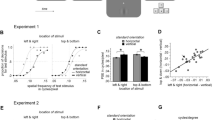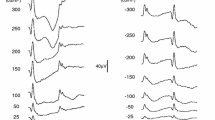Summary
Receptive fields of cat retinal ganglion cells were stimulated by a drifting sinusoidal luminance pattern of fixed (50%) contrast and the amplitude of the fundamental frequency component of response was determined as a function of spatial frequency. Frequency response functions for most cells were unimodal and skewed towards zero frequency when plotted on linear scales. At a fixed retinal location, cells of different classes had different frequency response functions. Heterogeneity within some of the classes could be largely removed by normalizing the axes, thus, revealing a common shape of function for the class. At a fixed retinal location, the maximum response obtained at each spatial frequency was always obtained from a cell of the brisk, rather than sluggish, classes. Spatial frequency resolution was highest for brisk-sustained cells and usually lowest for brisk transient cells.
Similar content being viewed by others
References
Cleland BG, Dubin MW, Levick WR (1971) Sustained and transient neurones in the cat's retina and lateral geniculate nucleus. J Physiol (Lond) 217: 473–496
Cleland BG, Harding T, Tuhmay-Keesey U (1979) Visual resolution and receptive field size: examination of two kinds of cat retinal ganglion cell. Science 205: 1015–1017
Cleland BG, Levick WR, Sanderson KJ (1973) Properties of sustained and transient ganglion cells in the cat retina. J Physiol (Lond) 228: 649–680
Cleland BG, Levick WR (1974) Brisk and sluggish concentrically organized ganglion cells in the cat's retina. J Physiol (Lond) 240: 421–456
Creutzfeldt OD, Sakmann B, Scheich H, Korn A (1970) Sensitivity distribution and spatial summation within receptive-field center of retinal on-center ganglion cells and transfer function of the retina. J Neurophysiol 33: 654–671
Enroth-Cugell C, Robson JG (1966) The contrast sensitivity of retinal ganglion cells of the cat. J Physiol (Lond) 187: 517–552
Enroth-Cugell C, Harding TH (1980) Summation of rod signals within the receptive field centre of cat retinal ganglion cells. J Physiol (Lond) 298: 235–250
Lennie P (1980) Perceptual signs of parallel pathways. Phil Trans R Soc Lond B290: 23–37
Levick WR (1972) Another tungsten microelectrode. Med Biol Engng 10: 510–515
Levick WR, Thibos LN (1980a) X/Y analysis of sluggish-concentric retinal ganglion cells of the cat. Exp Brain Res 41: A5-A6
Levick WR, Thibos LN (1980b) Orientation bias of cat retinal ganglion cells. Nature 286: 389–390
Levick WR, Thibos LN (1982) Analysis of orientation bias in cat retina. J Physiol (Lond) 329: 243–261
Levick WR, Thibos LN (1983) Receptive fields of cat ganglion cells: Classification and construction. J Prog Retinal Res 2: (in press)
Linsenmeier RA, Frishman LJ, Jakiela HG, Enroth-Cugell C (1982) Receptive field properties of X and Y cells in the cat retina derived from contrast sensitivity measurements. Vision Res 22: 1173–1183
Author information
Authors and Affiliations
Rights and permissions
About this article
Cite this article
Thibos, L.N., Levick, W.R. Spatial frequency characteristics of brisk and sluggish ganglion cells of the cat's retina. Exp Brain Res 51, 16–22 (1983). https://doi.org/10.1007/BF00236798
Received:
Issue Date:
DOI: https://doi.org/10.1007/BF00236798




